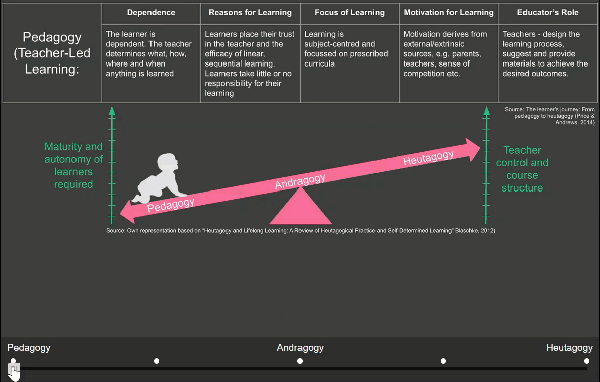The PAH continuum and its Seesaw Model

Academic activity in higher education institutions is very complex and serves the needs of unique and very diverse learners. Therefore, there is no justification for using only one (usually pedagogical) approach to learning, but rather for making learning opportunities more flexible and diverse. To this end, it is important to note that learning processes are dynamic and move along a continuum that combines (at least) the three most commonly used approaches: pedagogical, andragogical and heutagogical (although there are many more).
In other words, in order to develop a specific educational offer, it is very likely that we will do so in different stages. In each of them it is possible to use mainly one of the learning approaches. Depending on the objective of each stage, there will be an approach that best suits the needs of the learner and the circumstances of the learning environment.
That is why I propose the seesaw model to determine the most appropriate learning approach for each of the stages of the educational offer. In this model, we can see (first tab) that 2 main parameters can be used as a first indicator: the autonomy of the learner (left vertical axis) and the structure and control of the teacher (right vertical axis). As can be seen in the interactive graph, pedagogical learning schemes require less maturity and autonomy from the learner compared to andragogical or heutagogical schemes. On the contrary, the control of the teacher and the structure of the educational offer are dominant in pedagogical approaches, moderate in andragogical ones and very subtle in heutagogical ones.
In the second tab, it is showed the next very important factor to take into account, which is temporality (synchronous or asynchronous activities). Due to the nature of these learning approaches, we can say that, in general, the activities carried out synchronously have better results when they are carried out within pedagogical schemes. Therefore, when implementing andragogical approaches, a balance between synchronous and asynchronous activities works best. Due to the nature of the heutagogical approach, asynchronous activities are the protagonists of the approach, but this does not mean that synchronous activities are not carried out when necessary.
The third interactive graphic illustrates Gilly Salmon’s 5-phase model as an example to better understand how to implement the PAH continuum and the seesaw model.




2 Comments
Scott Clark · 11/10/2024 at 05:27
Nicely done PAH graphic! I am an education student studying the “3 gogies” for the past several years. I have never seen a more compelling graphic that explains the PAH continuum, thank you for posting.
Giovanni Fonseca · 11/15/2024 at 16:00
Glad you found it useful! I wish you all the best with your studies, don’t hesitate to re-use the H5P content, but please note the warning on the last tab.😉